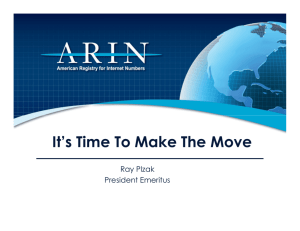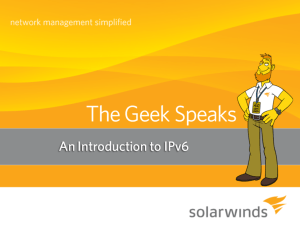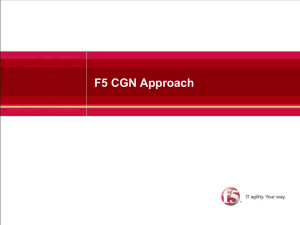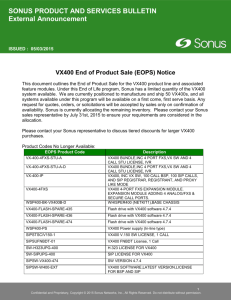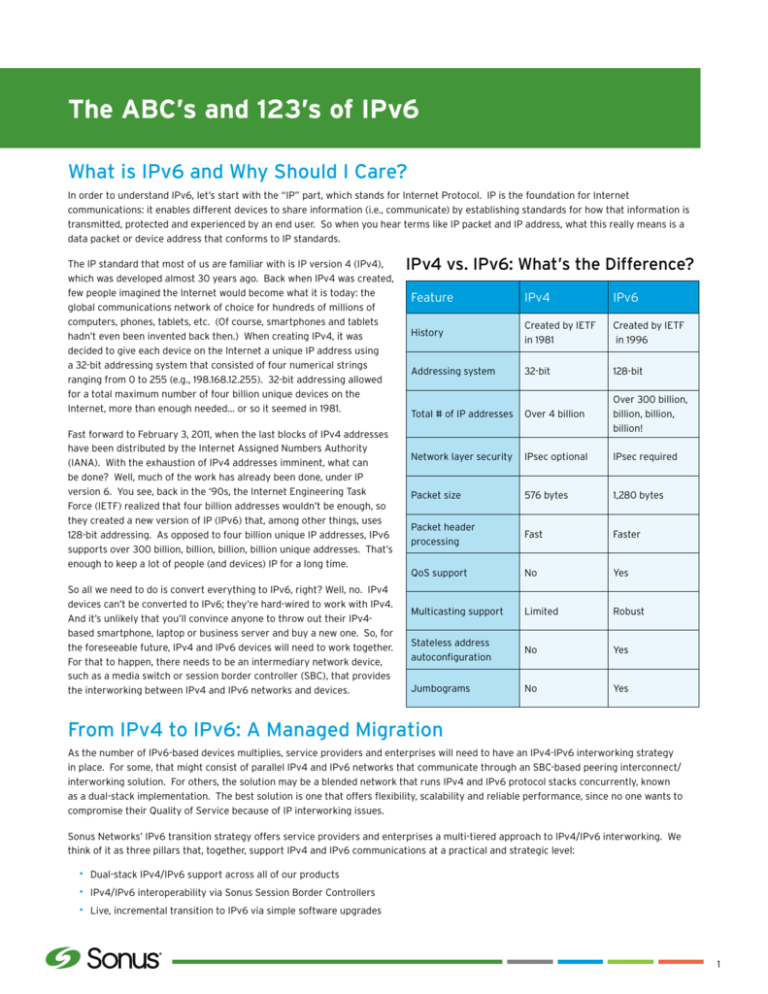
The ABC’s and 123’s of IPv6
What is IPv6 and Why Should I Care?
In order to understand IPv6, let’s start with the “IP” part, which stands for Internet Protocol. IP is the foundation for Internet
communications: it enables different devices to share information (i.e., communicate) by establishing standards for how that information is
transmitted, protected and experienced by an end user. So when you hear terms like IP packet and IP address, what this really means is a
data packet or device address that conforms to IP standards.
The IP standard that most of us are familiar with is IP version 4 (IPv4),
which was developed almost 30 years ago. Back when IPv4 was created,
few people imagined the Internet would become what it is today: the
global communications network of choice for hundreds of millions of
computers, phones, tablets, etc. (Of course, smartphones and tablets
hadn’t even been invented back then.) When creating IPv4, it was
decided to give each device on the Internet a unique IP address using
a 32-bit addressing system that consisted of four numerical strings
ranging from 0 to 255 (e.g., 198.168.12.255). 32-bit addressing allowed
for a total maximum number of four billion unique devices on the
Internet, more than enough needed… or so it seemed in 1981.
Fast forward to February 3, 2011, when the last blocks of IPv4 addresses
have been distributed by the Internet Assigned Numbers Authority
(IANA). With the exhaustion of IPv4 addresses imminent, what can
be done? Well, much of the work has already been done, under IP
version 6. You see, back in the ‘90s, the Internet Engineering Task
Force (IETF) realized that four billion addresses wouldn’t be enough, so
they created a new version of IP (IPv6) that, among other things, uses
128-bit addressing. As opposed to four billion unique IP addresses, IPv6
supports over 300 billion, billion, billion, billion unique addresses. That’s
enough to keep a lot of people (and devices) IP for a long time.
So all we need to do is convert everything to IPv6, right? Well, no. IPv4
devices can’t be converted to IPv6; they’re hard-wired to work with IPv4.
And it’s unlikely that you’ll convince anyone to throw out their IPv4based smartphone, laptop or business server and buy a new one. So, for
the foreseeable future, IPv4 and IPv6 devices will need to work together.
For that to happen, there needs to be an intermediary network device,
such as a media switch or session border controller (SBC), that provides
the interworking between IPv4 and IPv6 networks and devices.
IPv4 vs. IPv6: What’s the Difference?
Feature
IPv4
IPv6
History
Created by IETF
in 1981
Created by IETF
in 1996
Addressing system
32-bit
128-bit
Total # of IP addresses
Over 4 billion
Over 300 billion,
billion, billion,
billion!
Network layer security
IPsec optional
IPsec required
Packet size
576 bytes
1,280 bytes
Packet header
processing
Fast
Faster
QoS support
No
Yes
Multicasting support
Limited
Robust
Stateless address
autoconfiguration
No
Yes
Jumbograms
No
Yes
From IPv4 to IPv6: A Managed Migration
As the number of IPv6-based devices multiplies, service providers and enterprises will need to have an IPv4-IPv6 interworking strategy
in place. For some, that might consist of parallel IPv4 and IPv6 networks that communicate through an SBC-based peering interconnect/
interworking solution. For others, the solution may be a blended network that runs IPv4 and IPv6 protocol stacks concurrently, known
as a dual-stack implementation. The best solution is one that offers flexibility, scalability and reliable performance, since no one wants to
compromise their Quality of Service because of IP interworking issues.
Sonus Networks’ IPv6 transition strategy offers service providers and enterprises a multi-tiered approach to IPv4/IPv6 interworking. We
think of it as three pillars that, together, support IPv4 and IPv6 communications at a practical and strategic level:
• Dual-stack IPv4/IPv6 support across all of our products
• IPv4/IPv6 interoperability via Sonus Session Border Controllers
• Live, incremental transition to IPv6 via simple software upgrades
1
Dual-Stack Support
All Sonus products feature dual-stack support, which means they can communicate in both IPv4 and IPv6, choosing the appropriate protocol
based on an endpoint’s IP address. For example, a SIP proxy server routing a SIP session request from an IPv6 smartphone to an IPv4
server in another network would “speak” IPv6 to the smartphone and IPv4 to the server. Products with dual-stack support can operate in
both IPv4 and IPv6 networks.
SBC-Based Interworking
Because Sonus SBCs support dual-stack communications, they function exceptionally well as IPv4/IPv6 interworking agents in the network.
Acting as a back-to-back user agent for SIP signaling and RTP media at the network border, Sonus SBCs effectively decouple the IP protocol
for each leg of the SIP session so that IPv4 and IPv6 networks and devices can seamlessly communicate with each other.
Sonus SBCs support a variety of interworking scenarios:
• IPv4 and IPv6 signaling in the same call
• IPv4 and IPv6 media in the same call
• IPv4 signaling and IPv6 media (or the reverse) on a
particular leg
• IPv4 addresses within SIP and SDP, delivered in IPv6
packets (or the reverse)
A Live, Incremental Transition to IPv6
Sonus products are designed to provide a “painless” transition to IPv6 by allowing network operators to quickly turn on IPv6 capabilities
through a live software upgrade. This requires no hardware re-configurations or re-provisioning of existing Sonus equipment. For example,
network operators can choose to activate IPv6 on the network interfaces of an existing Sonus NBS device and/or add IPv6 peer addresses to
their existing IP Trunk Groups for simple, seamless network management. With Sonus products, IPv4 and IPv6 services can run on the same
device interfaces at the same time with the same service abstractions. Also, all Sonus products support migration of individual interfaces
from IPv4 to IPv6 independently, giving service providers and enterprises complete flexibility in their migration.
Now that you know more about IPv6 and what it means for your network, why not learn more about how Sonus Networks can help you get
there quickly and easily. Contact your Sonus sales representative for more information on our IPv6 solutions or send us an e-mail at sales@
sonusnet.com.
Sonus Networks
North American
Headquarters
Sonus Networks
APAC
Headquarters
Sonus Networks
EMEA
Headquarters
Sonus Networks
CALA
Headquarters
4 Technology Park Drive
Westford, MA 01886
U.S.A.
Tel: +1-855-GO-SONUS
1 Fullerton Road #02-01
One Fullerton
Singapore 049213
Singapore
Tel: +65 6832 5589
56 Kingston Road
Staines, Middlesex TW18 4NL
United Kingdom
Tel: +44-0-17-8422-5750
Mexico City, Campos
Eliseos Polanco
Andrés Bello 10, Pisos
6 y 7, Torre Forum
Col. Chapultepec Morales,
Ciudad de México
Mexico City, 11560 Mexico
Tel: +52 55 36010600
To learn more, call your Sonus sales representative
or visit us online at www.sonus.net
The content in this document is for informational purposes only and is subject to change by Sonus Networks without notice. While reasonable efforts have been made in the
preparation of this publication to assure its accuracy, Sonus Networks assumes no liability resulting from technical or editorial errors or omissions, or for any damages resulting from
the use of this information. Unless specifically included in a written agreement with Sonus Networks, Sonus Networks has no obligation to develop or deliver any future release or
upgrade or any feature, enhancement or function.
Copyright © 2012 Sonus Networks, Inc. All rights reserved. Sonus is a registered trademark of Sonus Networks, Inc. All other trademarks, service marks, registered trademarks or
registered service marks may be the property of their respective owners.
DS-1201 01/13
2


